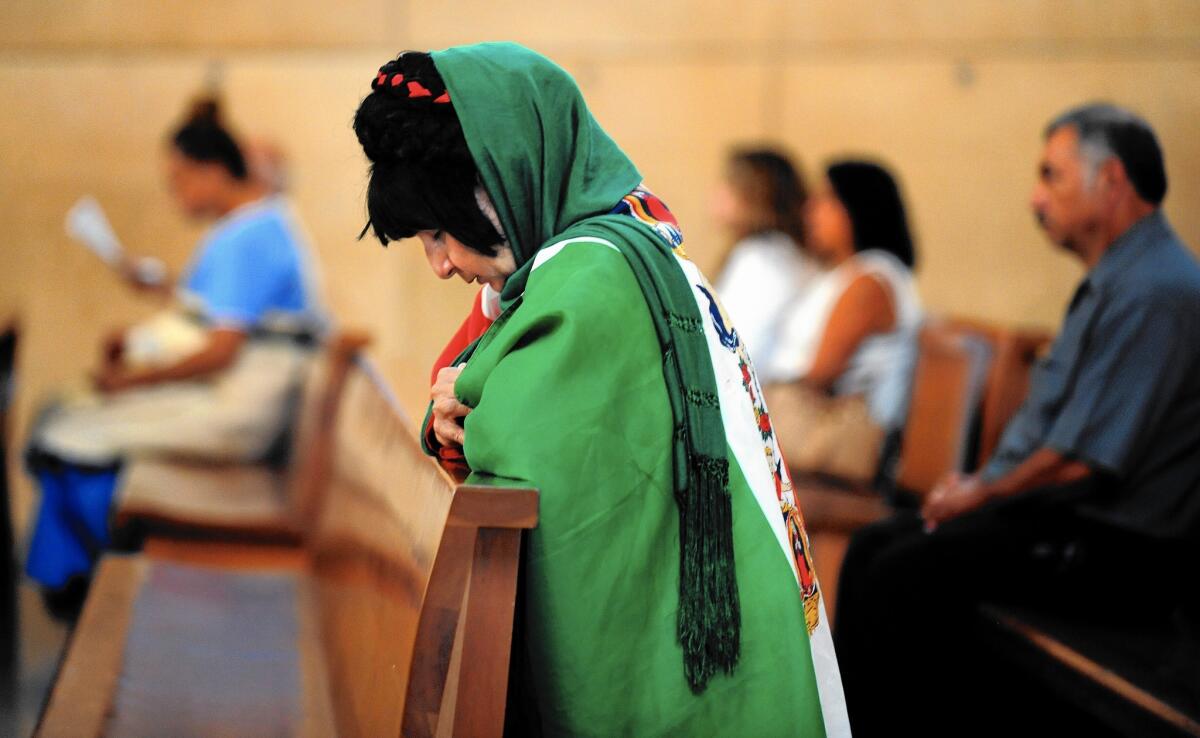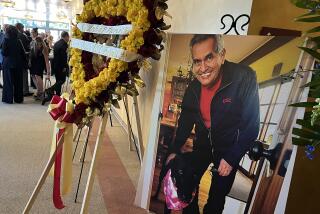Latino influence on Catholic Church is a backdrop to Pope Francis’ visit

A woman wrapped in a Mexican flag with the Virgin Mary on it prays at the Cathedral of Our Lady of the Angels in downtown Los Angeles.
- Share via
Reporting from PHOENIX — The Rev. Joevensi Balang, “Jovi” to his congregants, stepped to the lectern in the humble St. Augustine Roman Catholic Church, a low-slung brick building whose only evident decorations are seven wooden crosses mounted on each wall.
For a priest used to overseeing grand floral processions in the Philippines, this was a change for Balang, who arrived from Manila in 2013 to help this rapidly growing parish add extra services on Tuesday, Wednesday and Thursday nights.
------------
FOR THE RECORD: In the Sept. 22 Section A, an article about the increasing presence of Latinos in the Catholic church said that the Catholic League and its president, Bill Donohue, were opposed to immigration reform. Neither has opposed immigration reform.
------------
The problem: Few of the newly joining worshippers, most of them immigrants from Mexico and Central America, speak English, and Balang doesn’t speak Spanish. The church is growing so fast that parish leaders have been eager to press new priests into service, no matter their language qualifications. Balang reads the Spanish liturgy Thursday nights in a hesitant monotone, carefully scanning a script.
“Que la voluntad a Dios,” he urged his parishioners. Do the will of God.
The bedrock of American Catholicism for generations was in East Coast strongholds from Boston to Baltimore, where Irish, Polish, German and Italian immigrants dominated the church. But the demographic fulcrum in recent years has moved sharply to the West and South. Latinos now make up 34% of American Catholics — and their number is only expected to grow as the church’s declining white majority ages. Already, nearly half of all American Catholics younger than 30 are Latino.
See the most-read stories this hour >>
In the Los Angeles Archdiocese, the nation’s largest, 70% of the nearly 5 million parishoners — almost twice the proportion 20 years ago — are Latino. The archdiocese in 2011 consecrated the nation’s first Latino archbishop, Jose Horacio Gomez, and last year baptized nearly 70,000 infants.
“We baptized more infants in Los Angeles last year than the combined total of all the infant baptisms in the archdioceses of New York, Chicago, Philadelphia and Washington, D.C.,” Gomez told reporters at a conference last month.
The dramatic evolution in the church comes into sharp relief this week with the arrival of Pope Francis, the first Latin American pope, on his first U.S. visit. The papal itinerary — in Washington, New York and Philadelphia — has been criticized for bypassing the church’s most important growth market, in the Southwest.
Gomez said church officials had hoped Francis would at least come to California in light of this week’s scheduled canonization of the church’s first Latino saint in the U.S., Father Junipero Serra, the 18th century Franciscan friar who founded nine of California’s 21 missions.
“We have more experience being an important part of the Catholic Church in Los Angeles, we Latinos,” Gomez said in an interview.
Though the Catholic Church has seen robust growth in heavily Latino parishes such as this one in Phoenix, studies have shown that Latinos — like many other ethnic groups — are reassessing their relationship with their church.
Many older Latinos are choosing a more evangelical branch of Christianity, turning to movements that emphasize direct revelations from God. When asked about their switch, these former Catholics say they enjoy how frequently their new congregation meets, and how closely they hew to the Bible.
The number of Latinos who consider themselves Catholic has actually declined in recent years, from 67% in 2010 to 55% in 2015, according to Pew research.
The issue of younger Latinos has church leaders even more concerned. Many are choosing their own forms of private spirituality, or abandoning religion altogether.
“Most Latinos who have switched religious affiliation have done it before the age of 24,” said Hosffman Ospino, Boston College’s director of graduate programs in Hispanic ministry. “This means that the Catholic Church as an institution is falling short in its outreach to Hispanic youth. Losing Hispanic youth today will have a major impact in the vibrancy of Catholicism tomorrow.”
Church leaders are adopting a number of tactics to draw and keep younger Latinos in the church, including smartphone apps.
“What if we use the same marketing principles that corporations and nonprofits use?” said Cristofer Pereyra, director of the Hispanic mission office for the Roman Catholic Diocese of Phoenix. “One thing we’re doing is events. So you will see sponsorships from Coca-Cola, Budweiser — and the church.”
At Thursday Mass, the crowd at St. Augustine was mostly middle-aged and elderly, with a few scampering children shushed by adults.
Isidora Estrada, 56, stayed after Mass for a rally of church volunteers, a speech-like sermon delivered by a fluent Spanish speaker who exhorted the crowd to embrace Jesus in every aspect of their lives, and to bring that spirit to their homes and workplaces.
“You feel more connected to the words in Spanish,” Estrada said.
Two days later, in Los Angeles, a precocious 11-year-old named Jersey Vargas held up an embroidered cloth to Gomez emblazoned with an image of Our Lady of Guadalupe.
Would he offer a message of faith to immigrants, people like Jersey’s parents? Gomez bent down and kissed the handkerchief. “Have hope,” he said, in Spanish.
The political implications of the large growth of Latinos among American Catholics are only now emerging.
NEWSLETTER: Get the day’s top headlines from Times Editor Davan Maharaj >>
About 70% of Latino Catholics identify as Democrats, and the church itself has a long history of political activism. Catholics were a guiding force during the infancy of the labor movement in the U.S., and later they would take positions that put them to the right of the public, on issues such as abortion, and to the left, with the sanctuary movement that opened churches to refugees from Latin America seeking protection from deportation.
Today, Latino Catholics are vocal in the fight for immigration reform, rallying for change and putting a face to the struggles and stories of immigrants who come to the United States. Catholics in the Los Angeles Archdiocese wrote Congress in support of comprehensive immigration reform in 2013 — even while other, more traditional Catholics, including the Catholic League and its president, Bill Donohue, have opposed calls for immigration reform.
“Immigration reform is a family values issue. We need immigration reform as a matter of justice,” Gomez said.
The archbishop argues that the church is simply moving back toward its roots.
“The Hispanic presence in the church is the original face of the church in this country,” he said. “The first non-indigenous language spoken in this country was not English. It was Spanish.
“We shouldn’t think about Hispanics as newcomers to our society or to the church. Hispanics were here from the beginning.”
MORE ON THE POPE AND HIS U.S. VISIT
U.S. Catholic Church at a crossroads: Pope Francis appeals to competing currents
New York subway watchdog hopes Pope Francis climbs aboard
Pope Francis, whose vision has captivated the world, brings it to North America
More to Read
Sign up for Essential California
The most important California stories and recommendations in your inbox every morning.
You may occasionally receive promotional content from the Los Angeles Times.












